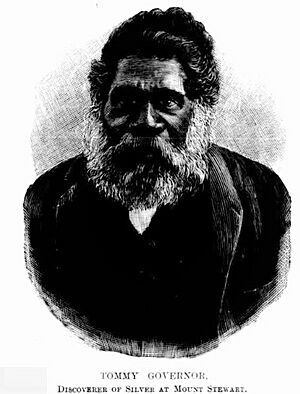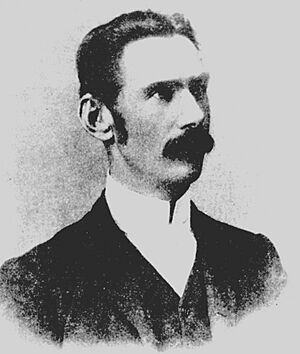Leadville, New South Wales facts for kids
Quick facts for kids LeadvilleNew South Wales |
|
|---|---|

Norman Horne Memorial Park
|
|
| Population | 169 (2016 census) |
| Postcode(s) | 2844 |
| Location |
|
| LGA(s) | Warrumbungle Shire |
| State electorate(s) | Barwon |
| Federal Division(s) | Parkes |
Leadville is a small town in New South Wales, Australia. It is part of the Warrumbungle Shire area. The town is about 376 kilometres (234 miles) north-west of Sydney, the state capital. In 2016, Leadville and the nearby areas had a population of 169 people.
Contents
History of Leadville
First Peoples of the Land
The land where Leadville is today traditionally belongs to the Wiradjuri people. The lands of the Kamilaroi people are also close by, to the north and east. Many local place names, like Dunedoo and Mudgee, come from the Wiradjuri language. This shows that the Wiradjuri people have a long history in this area.
How Leadville Became a Mining Town
Leadville started because of rich deposits of silver and lead ore nearby. The Mount Stewart, Extended, Mount Scott, Grosvenor, and Latimer Mines were all in this area.
An Aboriginal man named Tommy Governor found some interesting rocks near what would become the Mount Stewart mine. He showed these rocks to Mr. George Stewart. The rocks contained lead and silver. Mining began at Mount Stewart in 1888.
In 1891, a politician and businessman named Charles Garland bought 80 acres of land next to the Mount Stewart mine. He divided this land into 250 plots for houses and businesses. This new 'private town' was named Leadville, like another silver-lead mining town in Colorado, USA. Because one person owned the town's land, it was called a 'town' instead of a 'village' like nearby Dunedoo. The streets were named after people involved with the Mount Stewart mine.
As Leadville grew, many businesses moved there from Denison Town. This caused Denison Town to slowly disappear.
Mining Activity Over the Years
Mining in Leadville happened in three main periods:
- 1888 to 1894
- 1913 to 1935
- 1950 to 1952
Silver and lead ore were mined starting in 1888. By 1889, the Mount Stewart mine shaft was 255 feet deep. In 1890, a company was formed to run the Mount Stewart mine.
For about 14 months, starting in 1892, Leadville also had a smelter. A smelter is a factory that heats ore to get the metal out. This smelter produced 1,539 tons of lead and 292,093 ounces of silver. It used coke brought from far away, but also local charcoal and limestone.
Other mines opened nearby, like the Mount Steward Extended Mine and the Dynevor Silver and Gold Mining Co. Even a local storekeeper, William Latimer, had a mine on his land.
The Silver Price Crash and Changes
Mining was at its busiest in 1893. The town's population grew from 26 people in 1891 to about 1,000. But then, the price of silver suddenly dropped in a worldwide financial crisis in 1893. By 1894, the easy-to-mine ores at Mount Stewart were running out. Mining stopped around the end of 1894. This also meant that Charles Garland had many unsold land plots in the town.
After silver-lead mining ended, some Chinese shearers (people who shear sheep) and farm workers settled in the town.
In 1898, Charles Garland bought the Mount Stewart Mine again. He partnered with James Channon. They hoped to mine iron pyrites, which could be used to make sulfuric acid. In 1913, they sold a trial shipment of pyrites.
The Railway Arrives
Before 1920, the closest train station was at Craboon. In 1913, people started talking about building a train line from Craboon to Coolah, passing through Leadville. Charles Garland thought this new line would help lower the cost of sending Leadville's pyrites to fertiliser factories. A law to build the line was passed in 1915, and it opened in March 1920.
In 1916 and 1920, iron pyrites were shipped from Leadville using the new railway. Around 1919, Leadville and its surrounding area still had 772 people. However, James Channon died in 1920. Then, in October 1921, a strong storm damaged many buildings in the town and at the mine. Charles Garland lost interest in running the mine.
By 1926, the Leadville Mines were for sale. Garland had lost interest in reopening the mine by 1929, which made the townspeople upset because their future depended on the mine. Garland died in 1930.
Later Mining and Decline
In 1932, a group called the Mount Stewart Syndicate reopened the mine. They shipped iron pyrites to a company in Port Kembla. But mining stopped again in 1935. There had been some worker disagreements at Leadville. Also, a worker strike far away in Port Kembla was blamed for the mine closing and 50 men losing their jobs. People hoped the mine would reopen, but it didn't.
In 1951, the Leadville Mining Company produced a small amount of ore. In 1952, someone tried to get silver from the mine waste, but it didn't work. This was the last time minerals were produced in Leadville.
After the First World War, two areas near Leadville became 'soldier-settlement' areas. This meant that soldiers who had returned from the war could settle there. Leadville became a soldier-settler town as mining slowed down.
In 1935, Leadville had about 250 people (and 600 in the district). It had a school, post office, two hotels, two churches, a bakery, a butcher, and other shops. A passenger train from Sydney came almost every day.
Around 1960, Leadville started to decline. Businesses and services moved to Dunedoo. The school, which opened in 1892, closed in 1972. The post office, opened in 1891, closed in 1991.
The Leadville railway station opened in 1920 and closed in 1975. The train line itself stopped carrying trains in 1982.
Leadville's most famous person was Major-General Sir Ivan Dougherty (1907-1998). A road near the town is named Sir Ivan Dougherty Drive in his honour.
What Remains Today
Today, Leadville is a very quiet place. What's left of the town is just east of where the old Mount Stewart Mine used to be. Most of the original town plots are now part of larger properties. You can still see them on maps like Google Maps. The town's cemetery is also still there.




